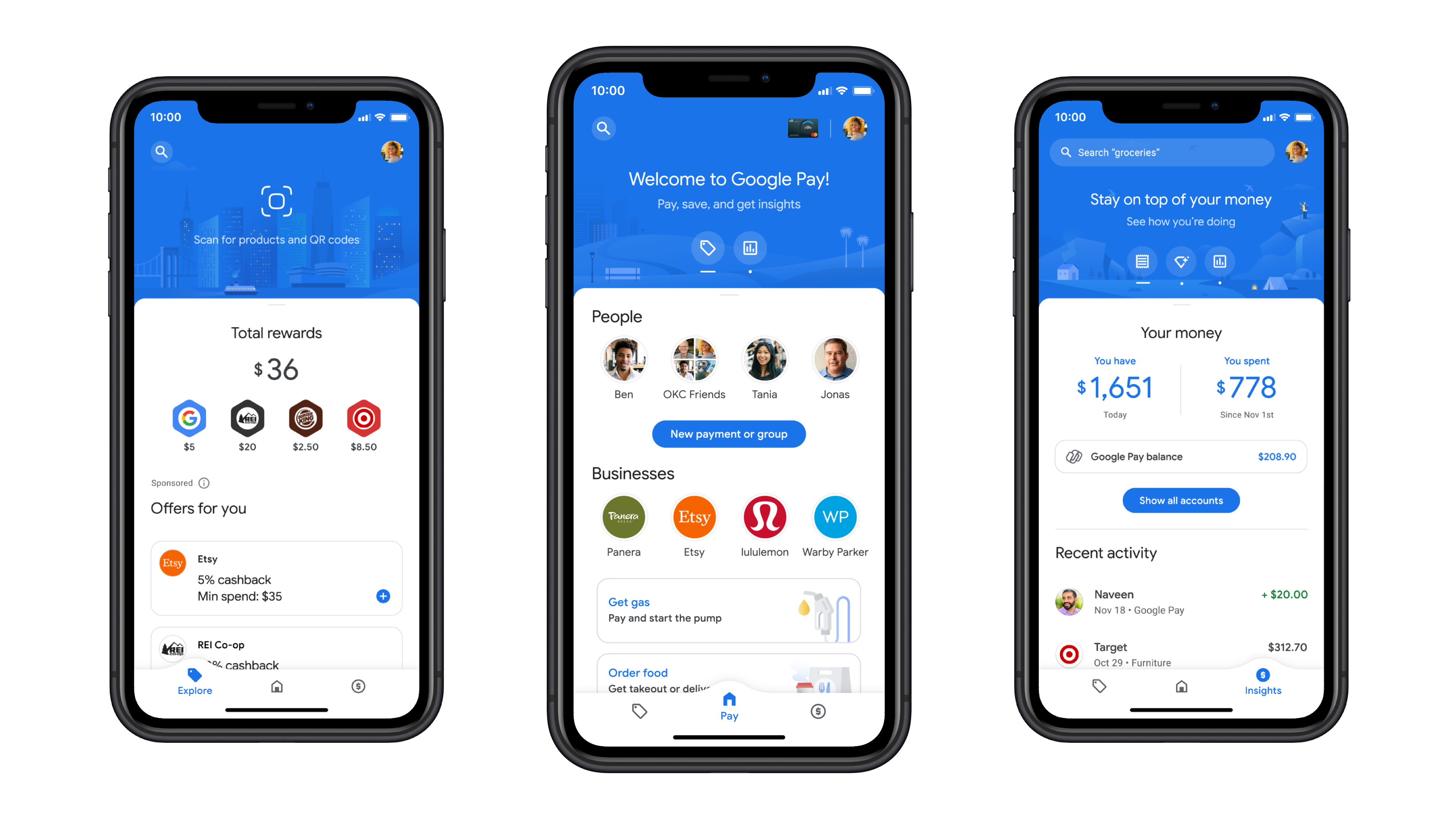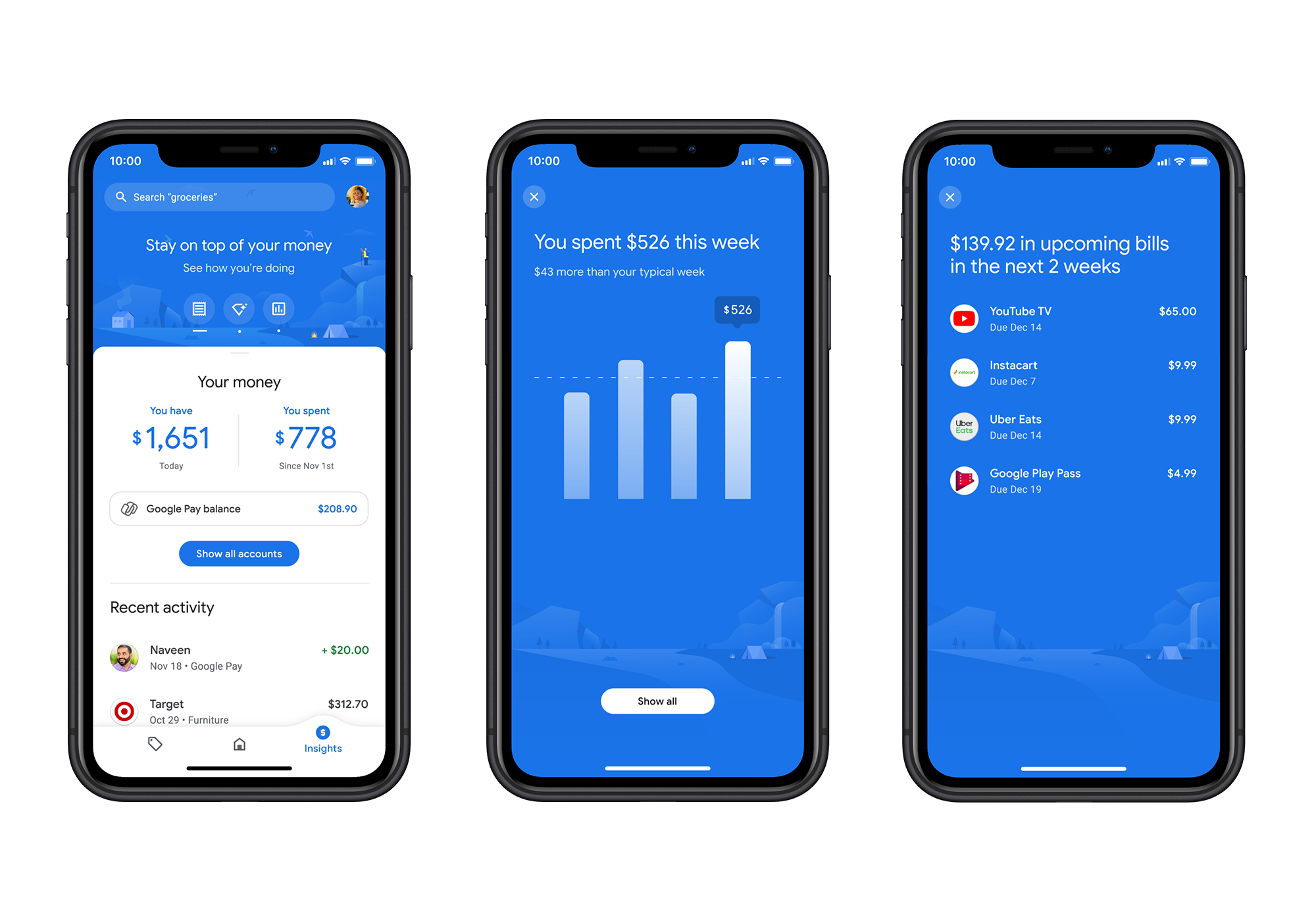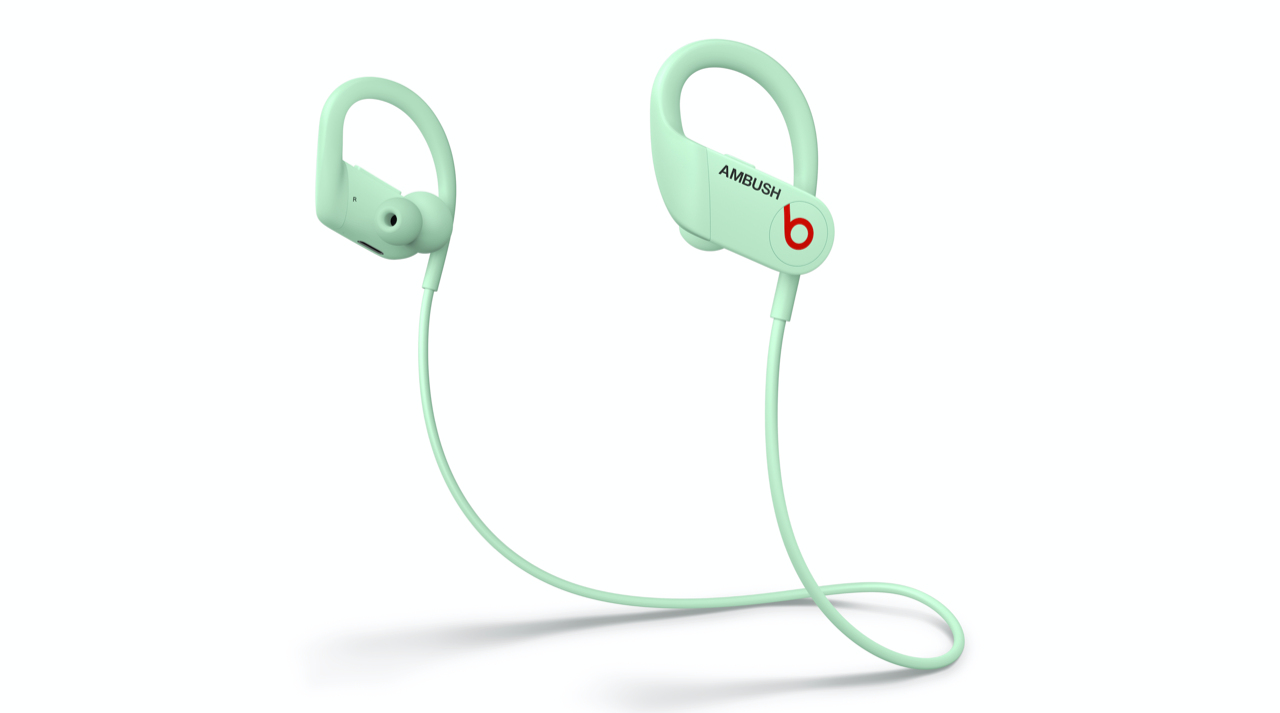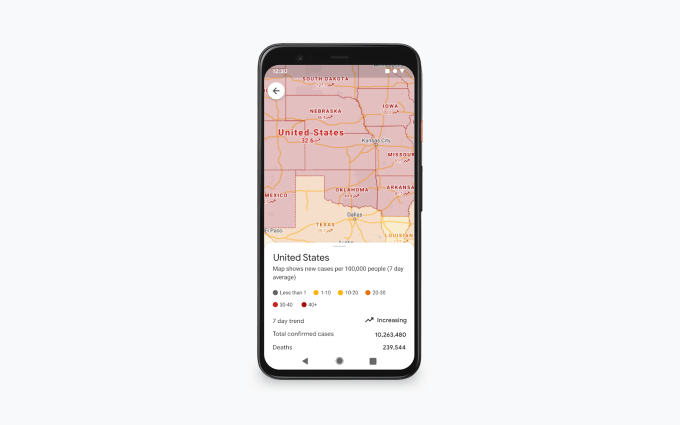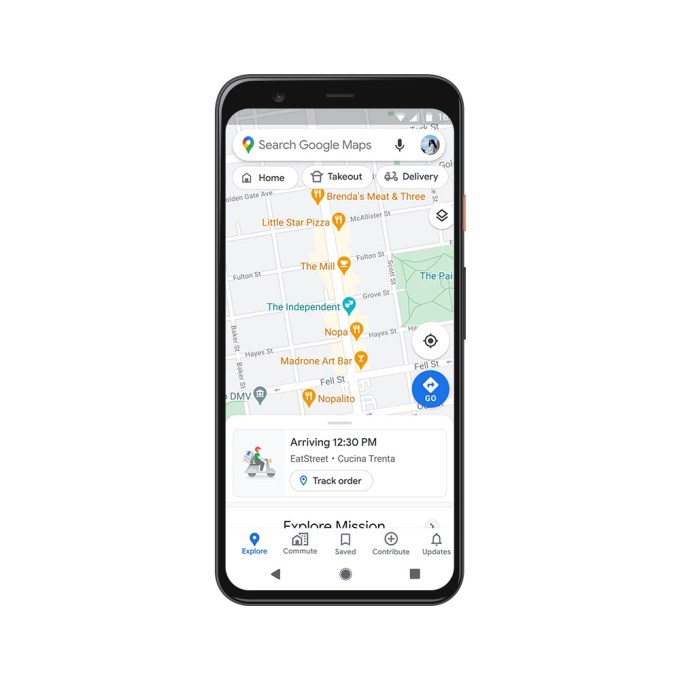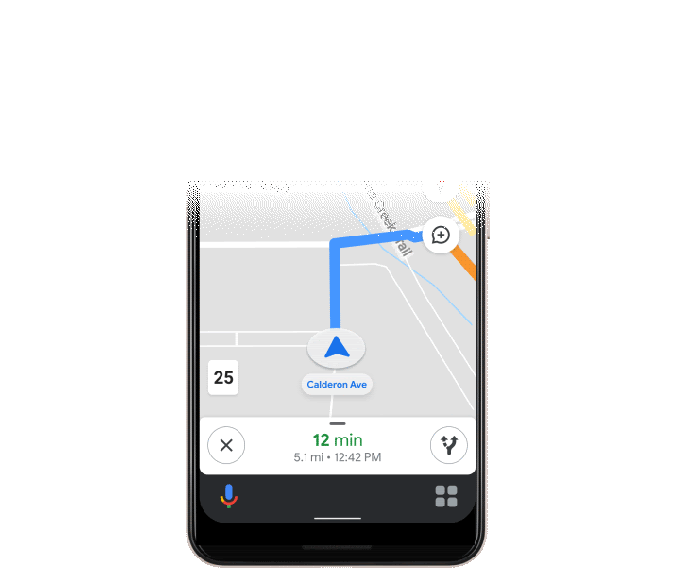Survival and strategy games are often played in stages. You have the early game where you’re learning the ropes, understanding systems. Then you have mid-game where you’re executing and gathering resources. The most fun part, for me, has always been the late mid-game where you’re in full control of your powers and skills and you’ve got resources to burn — where you execute on your master plan before the endgame gets hairy.
This is where Apple is in the game of power being played by the chip industry. And it’s about to be endgame for Intel.
Apple has introduced three machines that use its new M1 system on a chip, based on over a decade’s worth of work designing its own processing units based on the ARM instructions set. These machines are capable, assured and powerful, but their greatest advancements come in the performance per watt category.
I personally tested the 13” M1 MacBook Pro and after extensive testing, it’s clear that this machine eclipses some of the most powerful Mac portables ever made in performance while simultaneously delivering 2x-3x the battery life at a minimum.
These results are astounding, but they’re the product of that long early game that Apple has played with the A-series processors. Beginning in earnest in 2008 with the acquisition of PA Semiconductor, Apple has been working its way towards unraveling the features and capabilities of its devices from the product roadmaps of processor manufacturers.
The M1 MacBook Pro runs smoothly, launching apps so quickly that they’re often open before your cursor leaves your dock.

Video editing and rendering is super performant, only falling behind older machines when it leverages the GPU heavily. And even then only with powerful dedicated cards like the 5500M or VEGA II.
Compiling projects like WebKit produce better build times than nearly any machine (hell the M1 Mac Mini beats the Mac Pro by a few seconds). And it does it while using a fraction of the power.
This thing works like an iPad. That’s the best way I can describe it succinctly. One illustration I have been using to describe what this will feel like to a user of current MacBooks is that of chronic pain. If you’ve ever dealt with ongoing pain from a condition or injury, and then had it be alleviated by medication, therapy or surgery, you know how the sudden relief feels. You’ve been carrying the load so long you didn’t know how heavy it was. That’s what moving to this M1 MacBook feels like after using other Macs.
Every click is more responsive. Every interaction is immediate. It feels like an iOS device in all the best ways.
At the chip level, it also is an iOS device. Which brings us to…
iOS on M1
The iOS experience on the M1 machines is…present. That’s the kindest thing I can say about it. Apps install from the App Store and run smoothly, without incident. Benchmarks run on iOS apps show that they perform natively with no overhead. I even ran an iOS-based graphics benchmark which showed just fine.
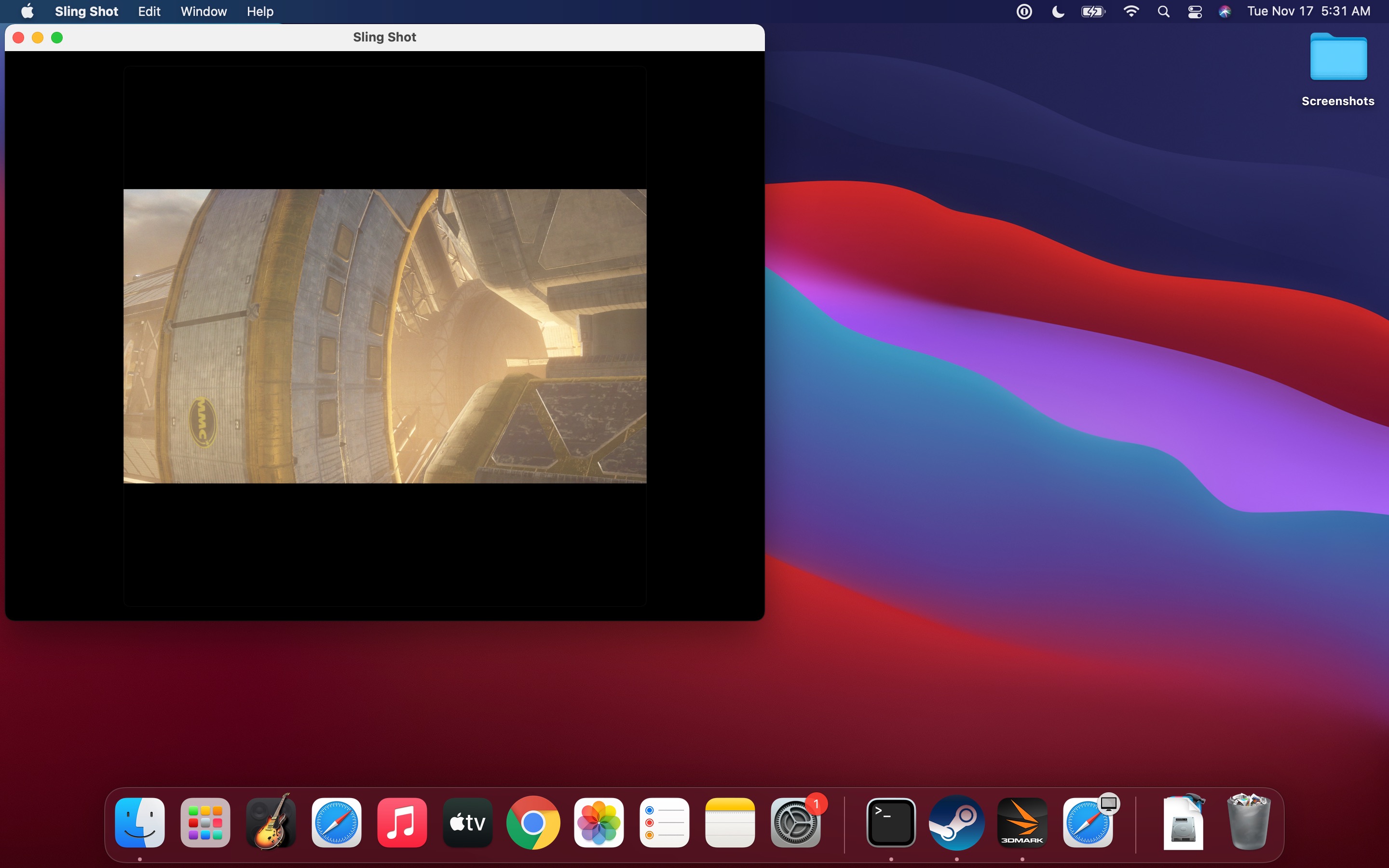
That, however, is where the compliments end. The current iOS app experience on an M1 machine running Big Sur is almost comical; it’s so silly. There is no default tool-tip that explains how to replicate common iOS interactions like swipe-from-edge — instead a badly formatted cheat sheet is buried in a menu. The apps launch and run in windows only. Yes, that’s right, no full-screen iOS apps at all. It’s super cool for a second to have instant native support for iOS on the Mac, but at the end of the day this is a marketing win, not a consumer experience win.
Apple gets to say that the Mac now supports millions of iOS apps, but the fact is that the experience of using those apps on the M1 is sub-par. It will get better, I have no doubt. But the app experience on the M1 is pretty firmly in this order right now: Native M1 app>Rosetta 2 app>Catalyst app> iOS app. Provided that the Catalyst ports can be bothered to build in Mac-centric behaviors and interactions, of course. But it’s clear that iOS, though present, is clearly not where it needs to be on M1.
Rosetta 2
There is both a lot to say and not a lot to say about Rosetta 2. I’m sure we’ll get more detailed breakdowns of how Apple achieved what it has with this new emulation layer that makes x86 applications run fine on the M1 architecture. But the real nut of it is that it has managed to make a chip so powerful that it can take the approximate 26% hit (see the following charts) in raw power to translate apps and still make them run just as fast if not faster than MacBooks with Intel processors.
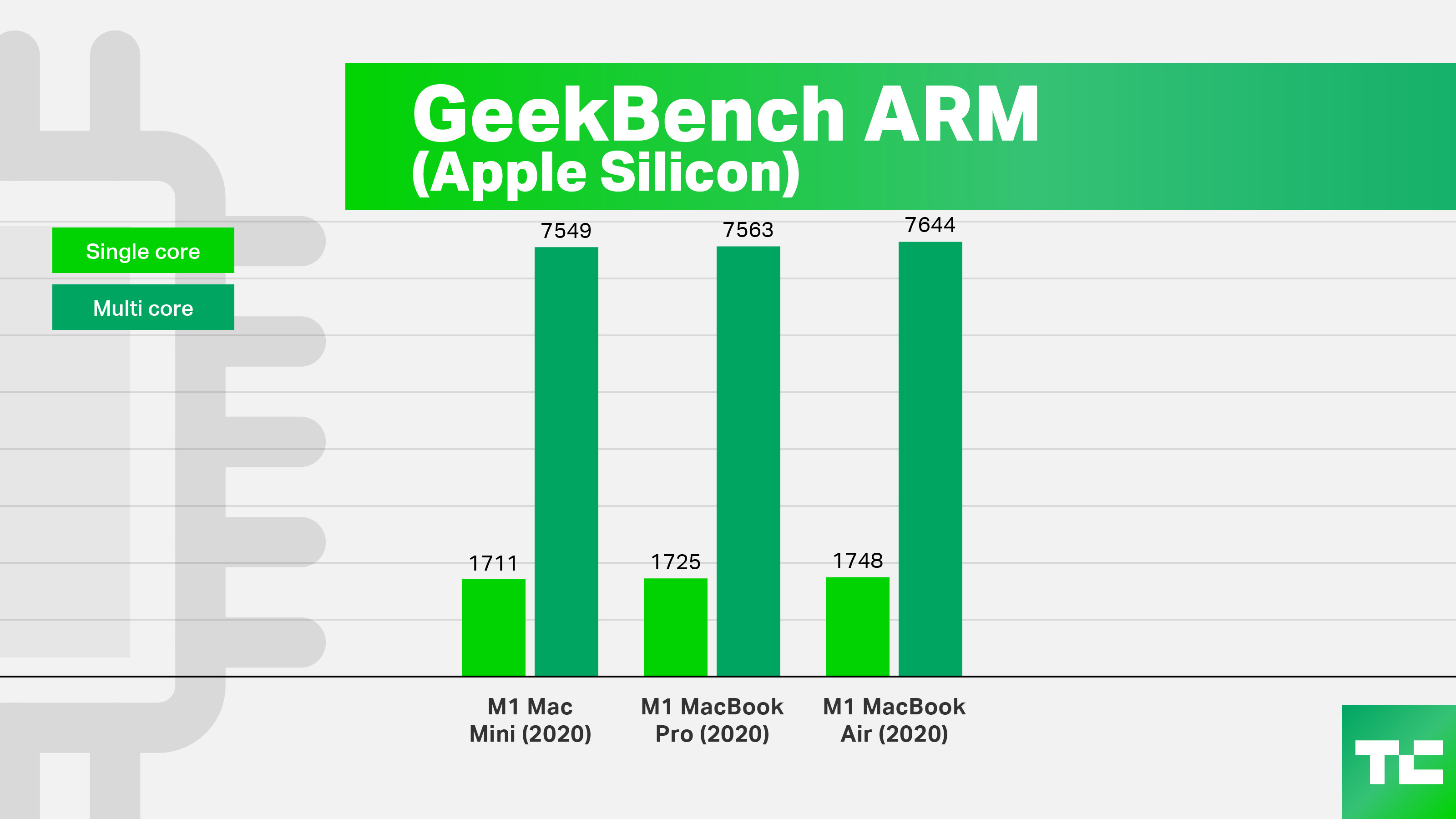
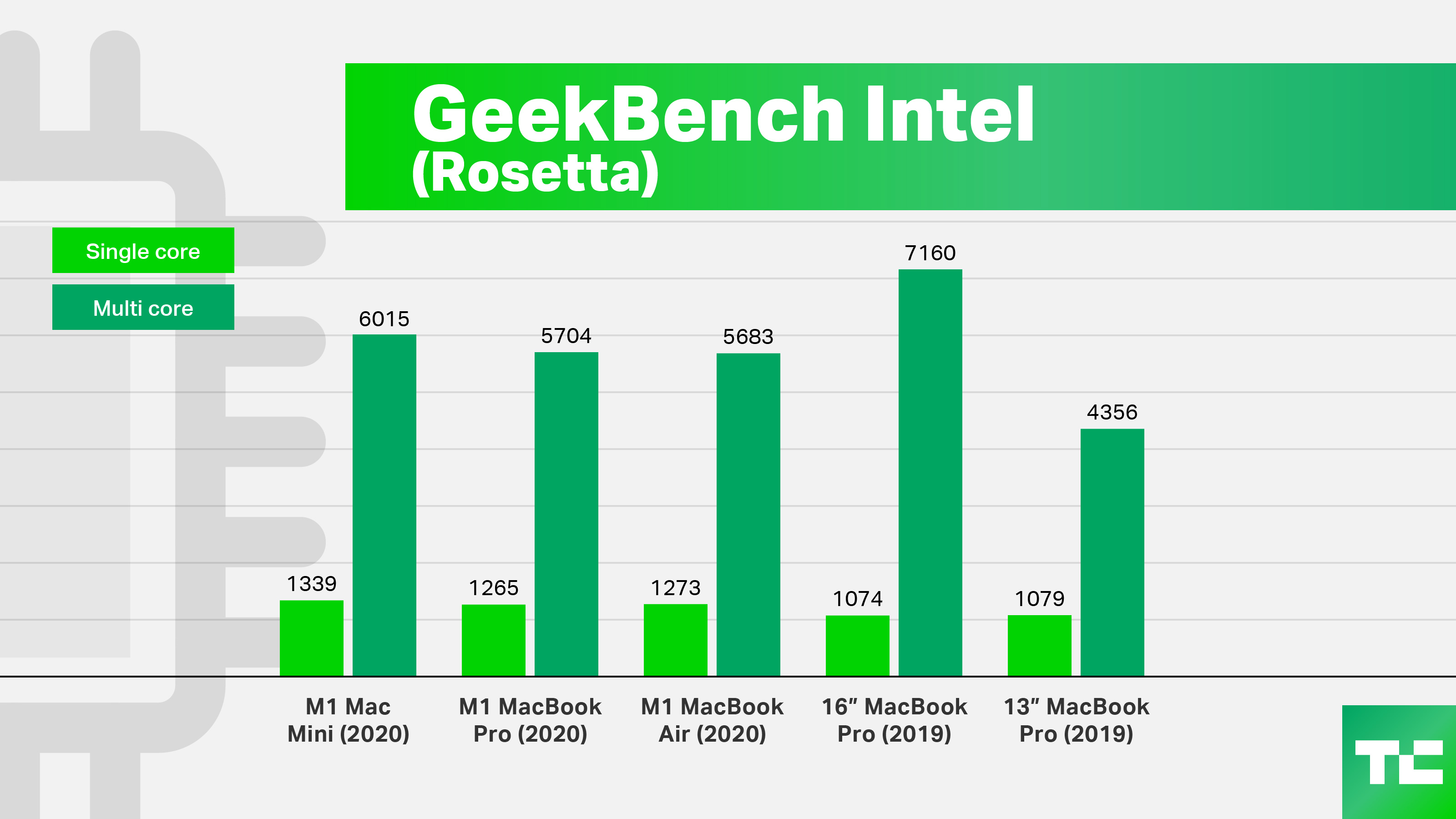
It’s pretty astounding. Apple would like us to forget the original Rosetta from the PowerPC transition as much as we would all like to forget it. And I’m happy to say that this is pretty easy to do because I was unable to track any real performance hit when comparing it to older, even ‘more powerful on paper’ Macs like the 16” MacBook Pro.
It’s just simply not a factor in most instances. And companies like Adobe and Microsoft are already hard at work bringing native M1 apps to the Mac, so the most needed productivity or creativity apps will essentially get a free performance bump of around 30% when they go native. But even now they’re just as fast. It’s a win-win situation.
Methodology
My methodology for my testing was pretty straightforward. I ran a battery of tests designed to push these laptops in ways that reflected both real world performance and tasks as well as synthetic benchmarks. I ran the benchmarks with the machines plugged in and then again on battery power to estimate constant performance as well as performance per watt. All tests were run multiple times with cooldown periods in between in order to try to achieve a solid baseline.
Here are the machines I used for testing:
- 2020 13” M1 MacBook Pro 8-core 16GB
- 2019 16” Macbook Pro 8-core 2.4GHz 32GB w/5500M
- 2019 13” MacBook Pro 4-core 2.8GHz 16GB
- 2019 Mac Pro 12-Core 3.3GHz 48GB w/AMD Radeon Pro Vega II 32GB
Many of these benchmarks also include numbers from the M1 Mac mini review from Matt Burns and the M1 MacBook Air, tested by Brian Heater which you can check out here.
Compiling WebKit
Right up top I’m going to start off with the real ‘oh shit’ chart of this piece. I checked WebKit out from GitHub and ran a build on all of the machines with no parameters. This is the one deviation from the specs I mentioned above as my 13” had issues that I couldn’t figure out so I had some Internet friends help me. Also thanks to Paul Haddad of Tapbots for guidance here.
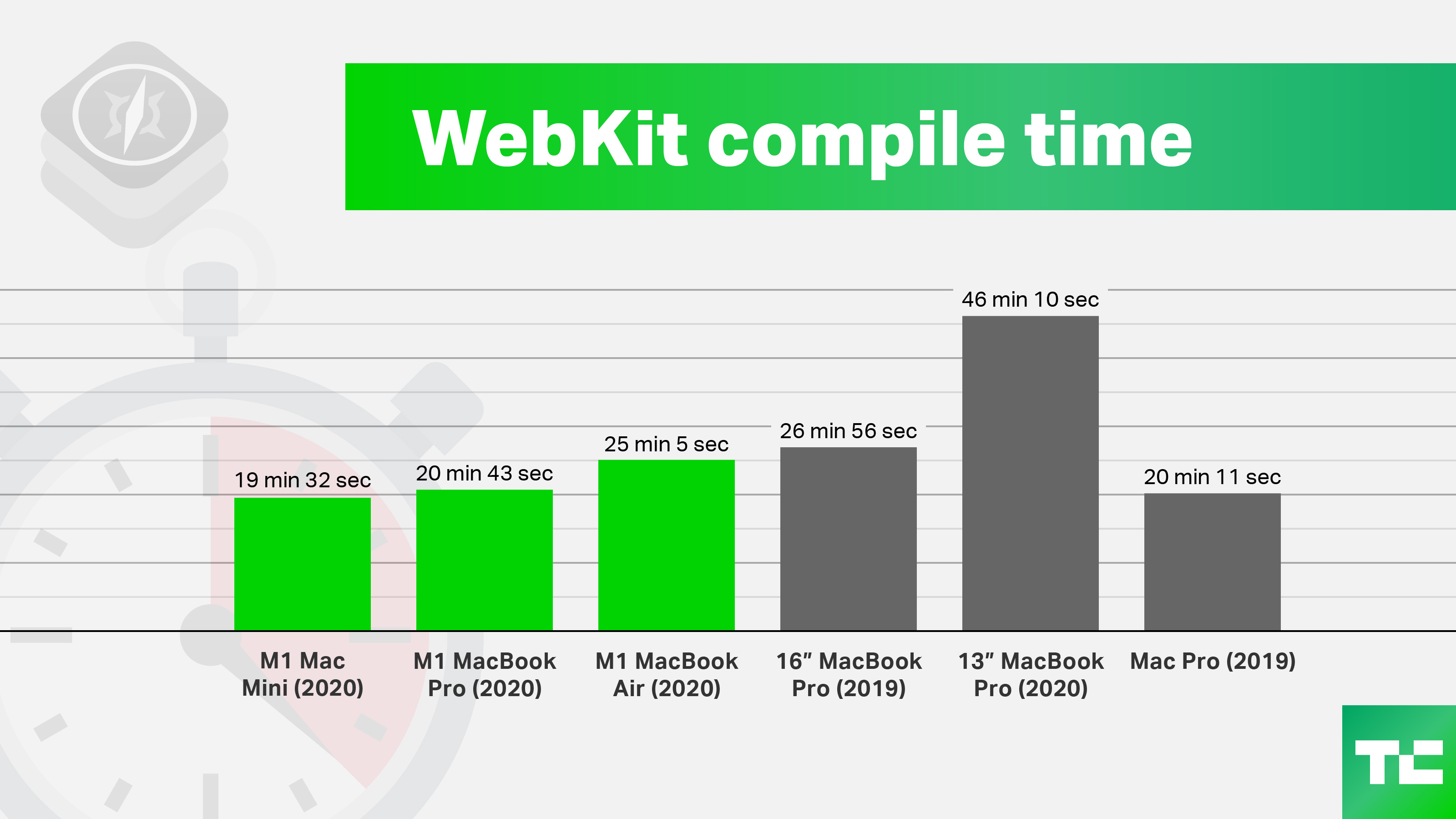
As you can see, the M1 performs admirably well across all models, with the MacBook and Mac Mini edging out the MacBook Air. This is a pretty straightforward way to visualize the difference in performance that can result in heavy tasks that last over 20 minutes, where the MacBook Air’s lack of active fan cooling throttles back the M1 a bit. Even with that throttling, the MacBook Air still beats everything here except for the very beefy MacBook Pro.
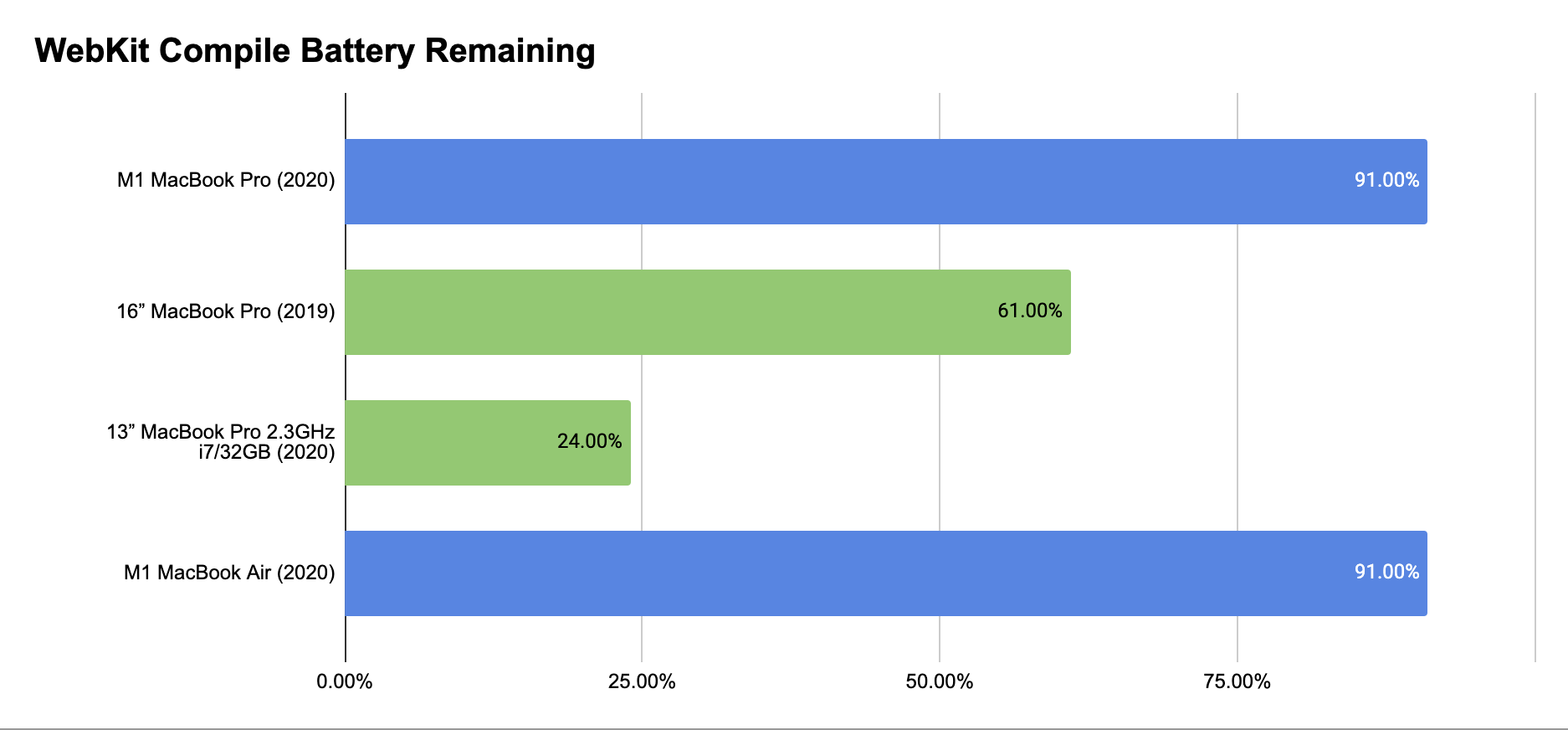
But, the big deal here is really this second chart. After a single build of WebKit, the M1 MacBook Pro had a massive 91% of its battery left. I tried multiple tests here and I could have easily run a full build of WebKit 8-9 times on one charge of the M1 MacBook’s battery. In comparison, I could have gotten through about 3 on the 16” and the 13” 2020 model only had one go in it.
This insane performance per watt of power is the M1’s secret weapon. The battery performance is simply off the chart. Even with processor-bound tasks. To give you an idea, throughout this build of WebKit the P-cluster (the power cores) hit peak pretty much every cycle while the E-cluster (the efficiency cores) maintained a steady 2GHz. These things are going at it, but they’re super power efficient.
Battery Life
In addition to charting battery performance in some real world tests, I also ran a couple of dedicated battery tests. In some cases they ran so long I thought I had left it plugged in by mistake, it’s that good.
I ran a mixed web browsing and web video playback script that hit a series of pages, waited for 30 seconds and then moved on to simulate browsing. The results return a pretty common sight in our tests, with the M1 outperforming the other MacBooks by just over 25%.
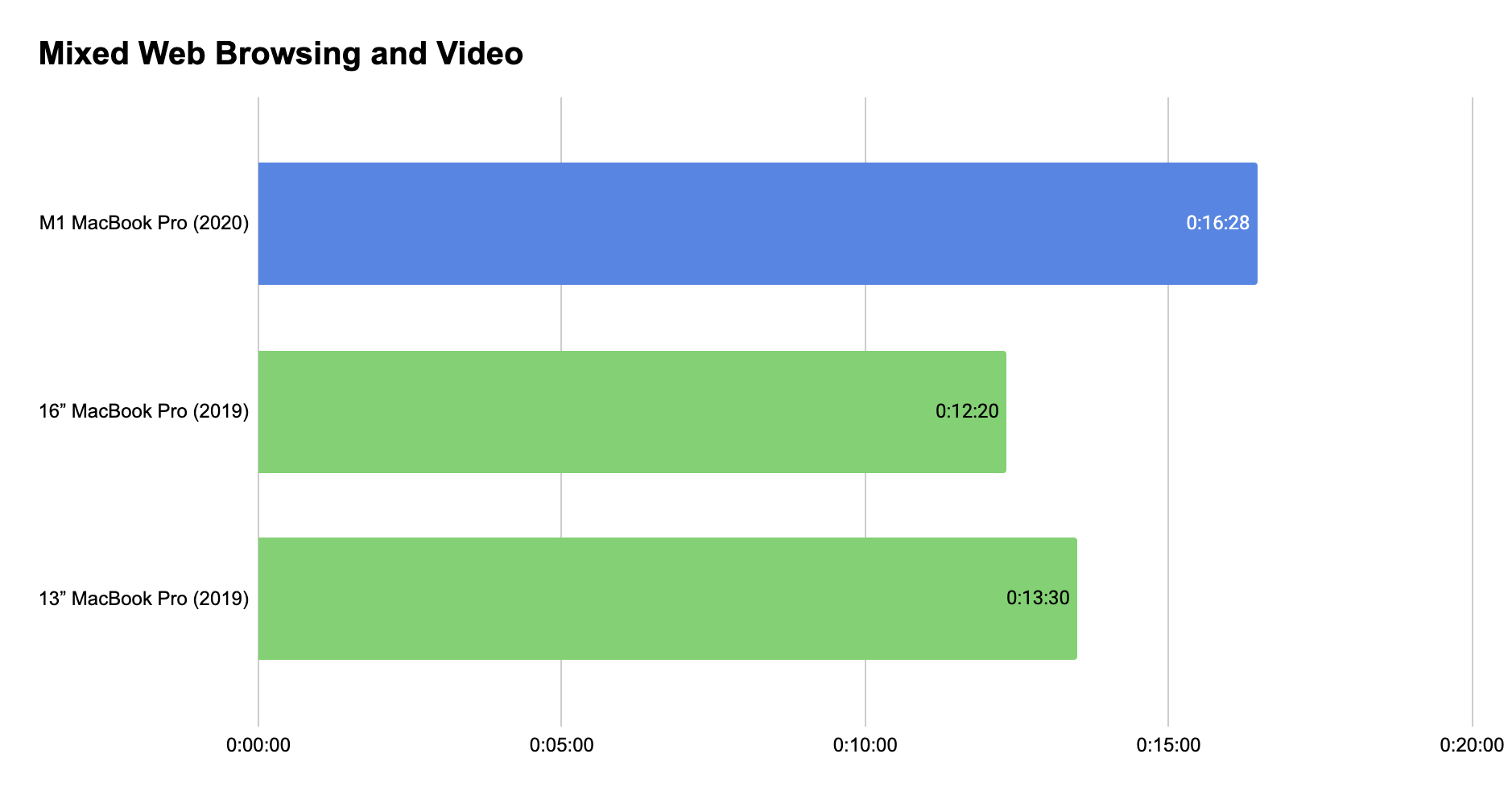
In fullscreen 4k/60 video playback, the M1 fares even better, clocking an easy 20 hours with fixed 50% brightness. On an earlier test, I left the auto-adjust on and it crossed the 24 hour mark easily. Yeah, a full day. That’s an iOS-like milestone.
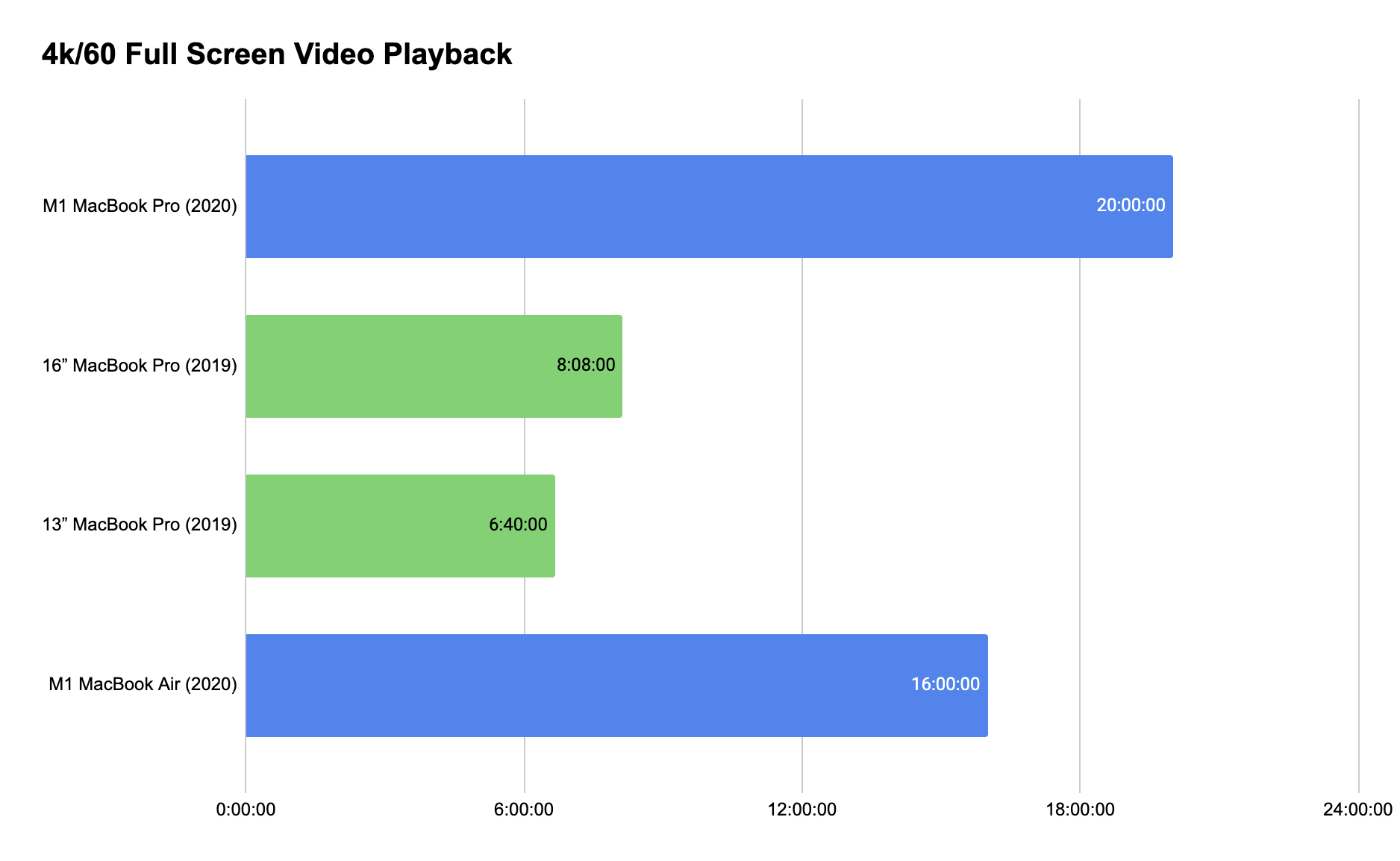
The M1 MacBook Air does very well also, but its smaller battery means a less playback time at 16 hours. Both of them absolutely decimated the earlier models.
Xcode Unzip
This was another developer-centric test that was requested. Once again, CPU bound, and the M1’s blew away any other system in my test group. Faster than the 8-core 16” MacBook Pro, wildly faster than the 13” MacBook Pro and yes, 2x as fast as the 2019 Mac Pro with its 3.3GHz Xeons.
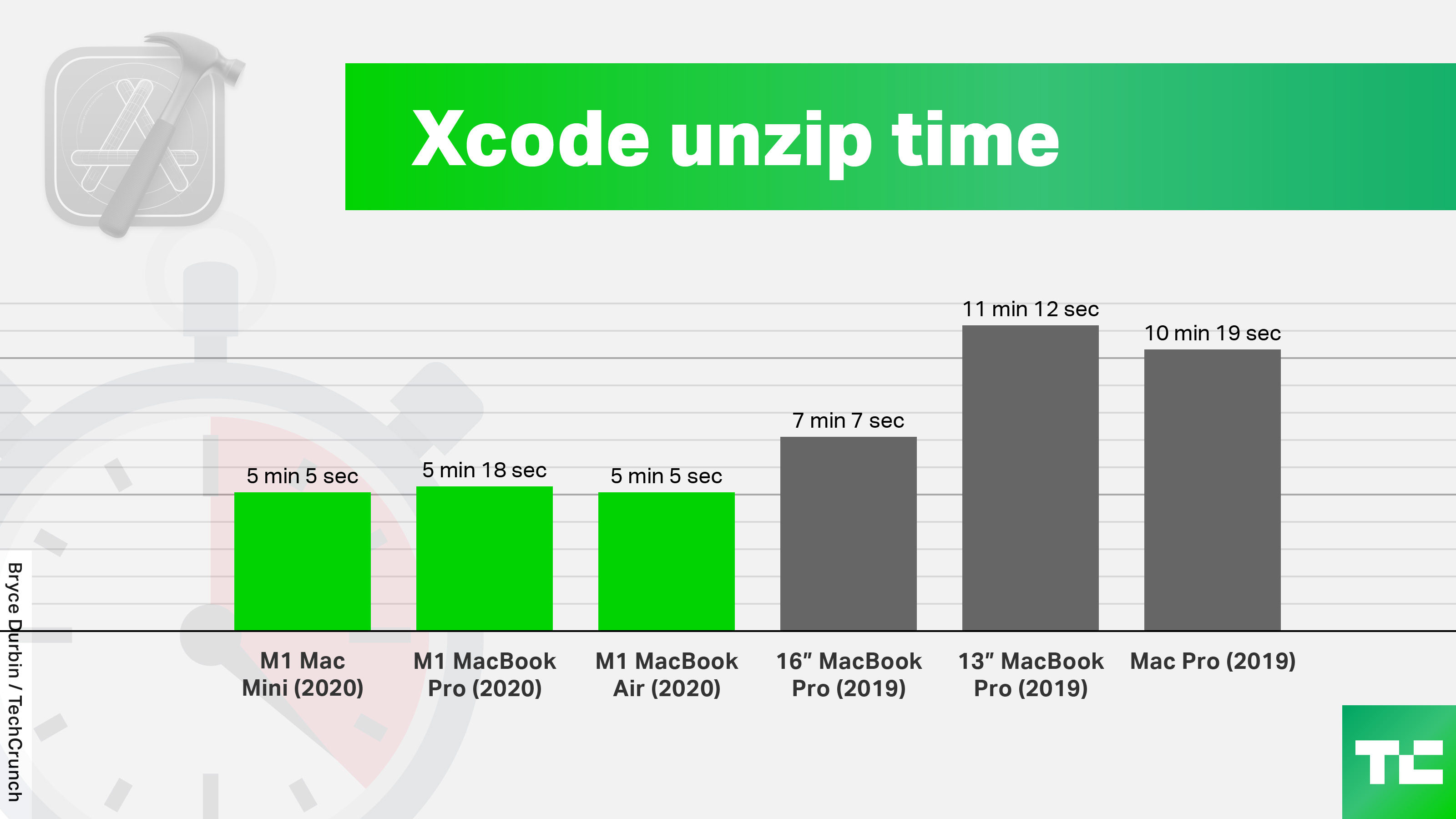
Image Credits: TechCrunch
For a look at the power curve (and to show that there is no throttling of the MacBook Pro over this period (I never found any throttling over longer periods by the way) here’s the usage curve.
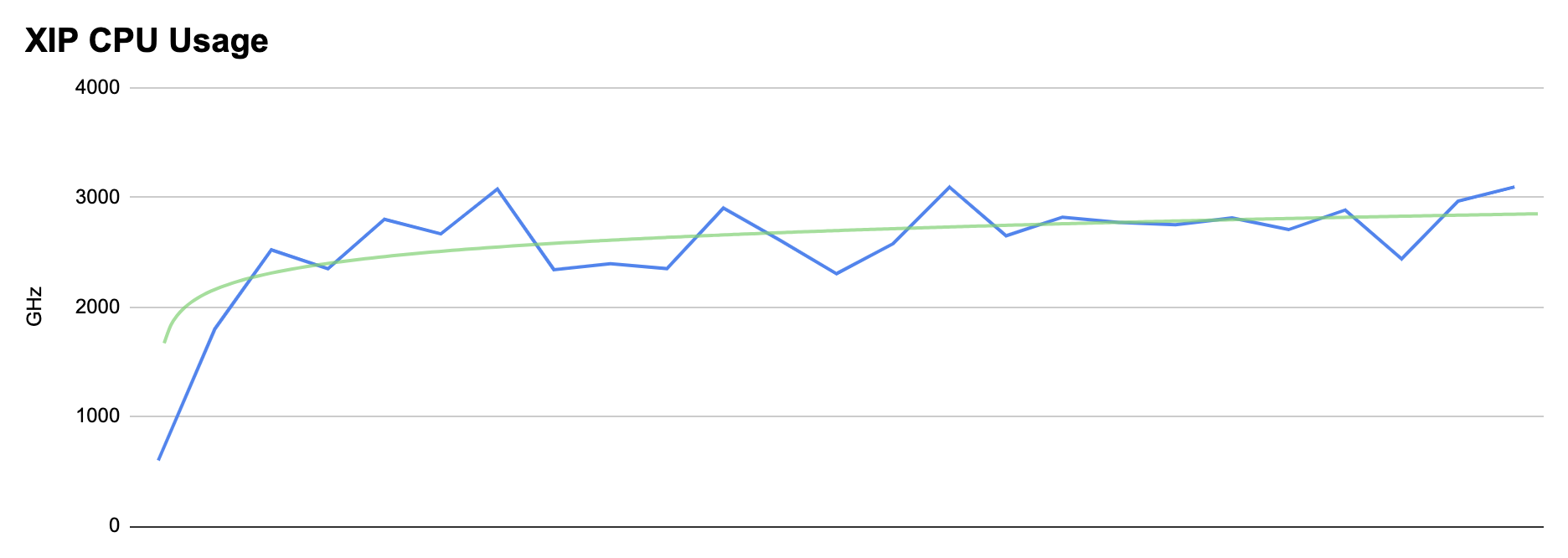
Unified Memory and Disk Speed
Much ado has been made of Apple including only 16GB of memory on these first M1 machines. The fact of it, however, is that I have been unable to push them hard enough yet to feel any effect of this due to Apple’s move to unified memory architecture. Moving RAM to the SoC means no upgradeability — you’re stuck on 16GB forever. But it also means massively faster access
If I was a betting man I’d say that this was an intermediate step to eliminating RAM altogether. It’s possible that a future (far future, this is the play for now) version of Apple’s M-series chips could end up supplying memory to each of the various chips from a vast pool that also serves as permanent storage. For now, though, what you’ve got is a finite, but blazing fast, pool of memory shared between the CPU cores, GPU and other SoC denizens like the Secure Enclave and Neural Engine.
While running many applications simultaneously, the M1 performed extremely well. Because this new architecture is so close, with memory being a short hop away next door rather than out over a PCIE bus, swapping between applications was zero issue. Even while tasks were run in the background — beefy, data heavy tasks — the rest of the system stayed flowing.
Even when the memory pressure tab of Activity Monitor showed that OS X was using swap space, as it did from time to time, I noticed no slowdown in performance.
Though I wasn’t able to trip it up I would guess that you would have to throw a single, extremely large file at this thing to get it to show any amount of struggle.
The SSD in the M1 MacBook Pro is running on a PCIE 3.0 bus, and its write and read speeds indicate that.
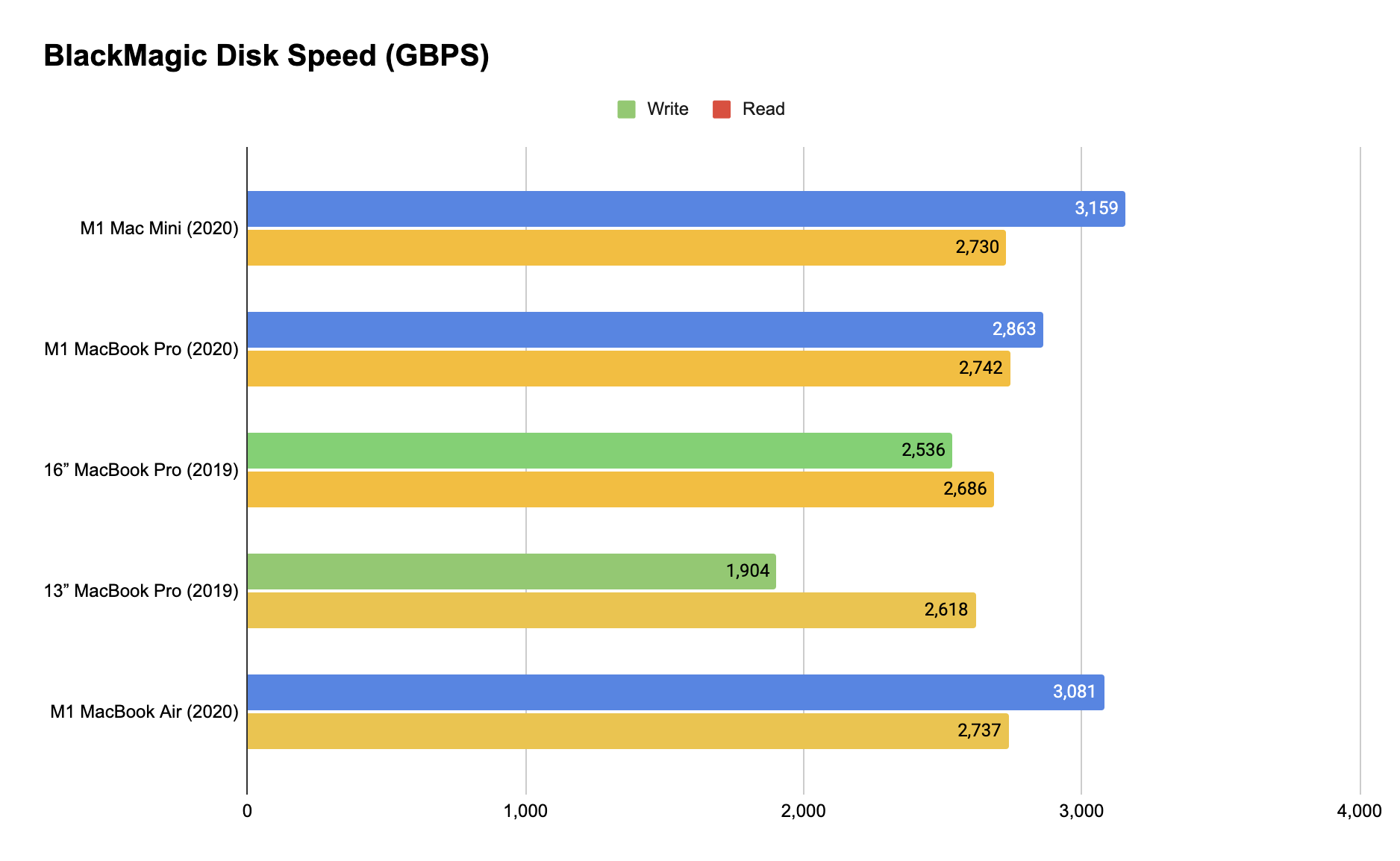
Thunderbolt
The M1 MacBook Pro has two Thunderbolt controllers, one for each port. This means that you’re going to get full PCIE 4.0 speeds out of each and that it seems very likely that Apple could include up to 4 ports in the future without much change in architecture.
This configuration also means that you can easily power an Apple Pro Display XDR and another monitor besides. I was unable to test two Apple Pro Display XDR monitors side-by-side.
Cooling and throttling
No matter how long the tests I ran were, I was never able to ascertain any throttling of the CPU on the M1 MacBook Pro. From our testing it was evident that in longer operations (20-40 minutes on up) it was possible to see the MacBook Air pulling back a bit over time. Not so with the Macbook Pro.
Apple says that it has designed a new ‘cooling system’ in the M1 MacBook Pro, which holds up. There is a single fan but it is noticeably quieter than either of the other fans. In fact, I was never able to get the M1 much hotter than ‘warm’ and the fan ran at speeds that were much more similar to that of a water cooled rig than the turbo engine situation in the other MacBooks.

Even running a long, intense Cinebench 23 session could not make the M1 MacBook get loud. Over the course of the mark running all high-performance cores regularly hit 3GHz and the efficiency cores hitting 2GHz. Despite that, it continued to run very cool and very quiet in comparison to other MacBooks. It’s the stealth bomber at the Harrier party.
In that Cinebench test you can see that it doubles the multi-core performance of last year’s 13” MacBook and even beats out the single-core performance of the 16” MacBook Pro.
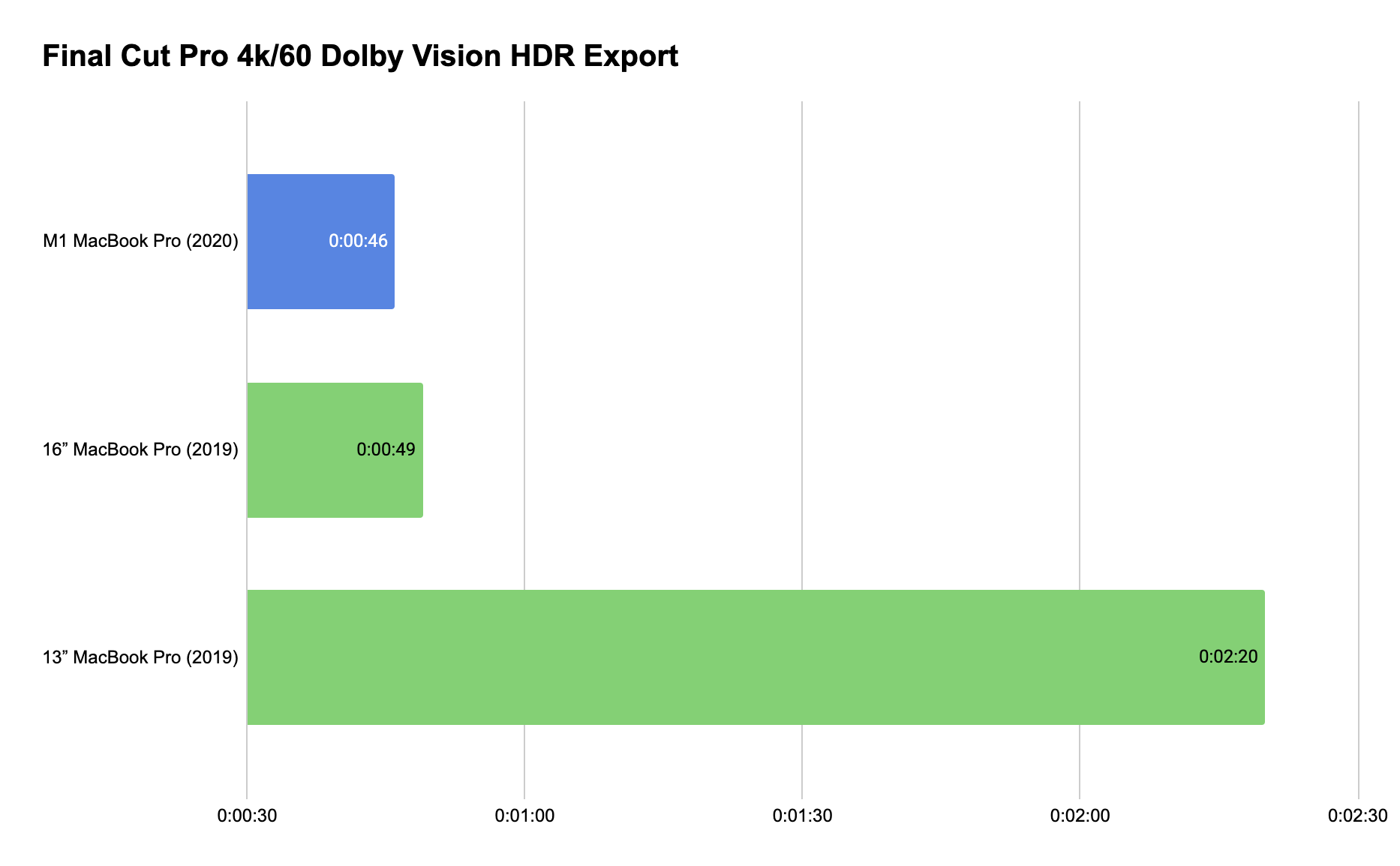
I ran a couple of Final Cut Pro tests with my test suite. First was a 5 minute 4k60 timeline shot with iPhone 12 Pro using audio, transitions, titles and color grading. The M1 Macbook performed fantastic, slightly beating out the 16” MacBook Pro.

With an 8K timeline of the same duration, the 16” MacBook Pro with its Radeon 5500M was able to really shine with FCP’s GPU acceleration. The M1 held its own though, showing 3x faster speeds than the 13” MacBook Pro with its integrated graphics.
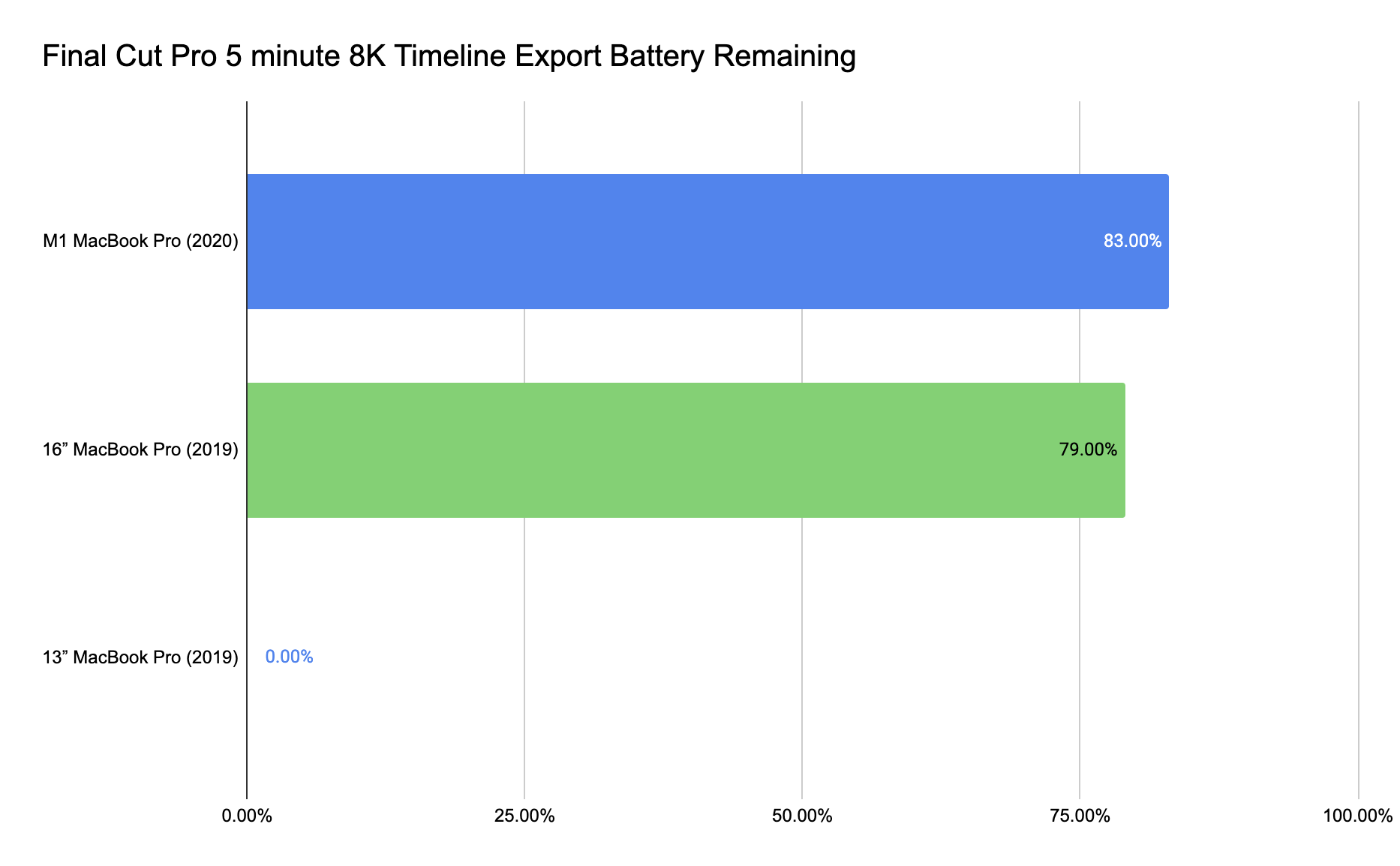
And, most impressively, the M1 MacBook Pro used extremely little power to do so. Just 17% of the battery to output an 81GB 8k render. The 13” MacBook Pro could not even finish this render on one battery charge.

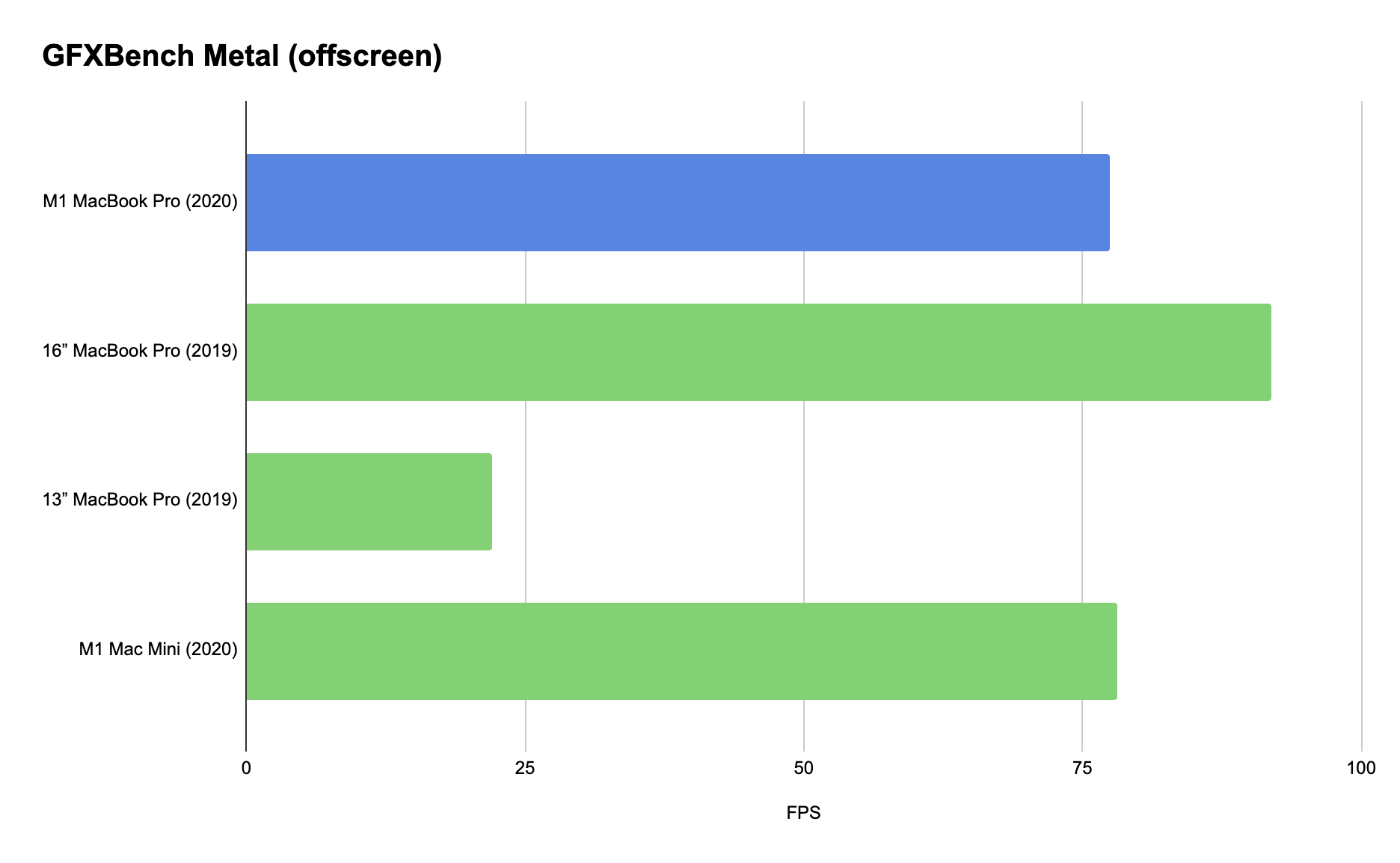
As you can see in these GFXBench charts, while the M1 MacBook Pro isn’t a powerhouse gaming laptop we still got some very surprising and impressive results in tests of the GPU when a rack of Metal tests were run on it. The 16″ MBP still has more raw power, but rendering games at retina is still very possible here.
The M1 is the future of CPU design
All too often over the years we’ve seen Mac releases hamstrung by the capabilities of the chips and chipsets that were being offered by Intel. Even as recently as the 16” MacBook Pro, Apple was stuck a generation or more behind. The writing was basically on the wall once the iPhone became such a massive hit that Apple began producing more chips than the entire rest of the computing industry combined.
Apple has now shipped over 2 billion chips, a scale that makes Intel’s desktop business look like a luxury manufacturer. I think it was politic of Apple to not mention them by name during last week’s announcement, but it’s also clear that Intel’s days are numbered on the Mac and that their only saving grace for the rest of the industry is that Apple is incredibly unlikely to make chips for anyone else.
Years ago I wrote an article about the iPhone’s biggest flaw being that its performance per watt limited the new experiences that it was capable of delivering. People hated that piece but I was right. Apple has spent the last decade “fixing” its battery problem by continuing to carve out massive performance gains via its A-series chips all while maintaining essentially the same (or slightly better) battery life across the iPhone lineup. No miracle battery technology has appeared, so Apple went in the opposite direction, grinding away at the chip end of the stick.
What we’re seeing today is the result of Apple flipping the switch to bring all of that power efficiency to the Mac, a device with 5x the raw battery to work with. And those results are spectacular.

from iPhone – TechCrunch https://ift.tt/3lzPQom
